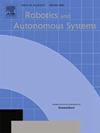A stable and safe method for two-leg balancing of a quadruped robot using a neural-network-based controller
IF 4.3
2区 计算机科学
Q1 AUTOMATION & CONTROL SYSTEMS
引用次数: 0
Abstract
This study presents a control strategy using a neural controller to achieve postural control in underactuated quadrupedal robots, such as balancing on two feet constrained to be fixed. Such a configuration, as in climbing animals, is the most appropriate solution for traversing uneven, slippery terrains with few safe footholds. This is one of the most challenging poses to achieve and maintain under dynamic stability in a complex, high-order, underactuated robotic structure with two fixed points. The neural network learns by mimicking an optimal controller on a variation-based linearized model of the robot. A hybrid training strategy, formulated within a Linear Matrix Inequality framework, was developed to minimize the classical accuracy index while incorporating additional constraints to ensure stability and safety based on Lyapunov theory.For the first time, a Lyapunov neural controller was successfully applied to an underactuated dynamic system to maintain critical stability conditions, extending the region of attraction for the desired equilibrium beyond that of the optimal base controller used as a teacher. The neural controller demonstrates its efficiency against disturbances and novel reference poses not encountered during training, showcasing impressive generalization capabilities. Another key advantage is the significantly increased bandwidth of the neural control loop, which is several orders of magnitude higher than that of currently used recursive optimal controllers. This strategy is validated using a realistic dynamic simulation framework.
求助全文
约1分钟内获得全文
求助全文
来源期刊

Robotics and Autonomous Systems
工程技术-机器人学
CiteScore
9.00
自引率
7.00%
发文量
164
审稿时长
4.5 months
期刊介绍:
Robotics and Autonomous Systems will carry articles describing fundamental developments in the field of robotics, with special emphasis on autonomous systems. An important goal of this journal is to extend the state of the art in both symbolic and sensory based robot control and learning in the context of autonomous systems.
Robotics and Autonomous Systems will carry articles on the theoretical, computational and experimental aspects of autonomous systems, or modules of such systems.
 求助内容:
求助内容: 应助结果提醒方式:
应助结果提醒方式:


